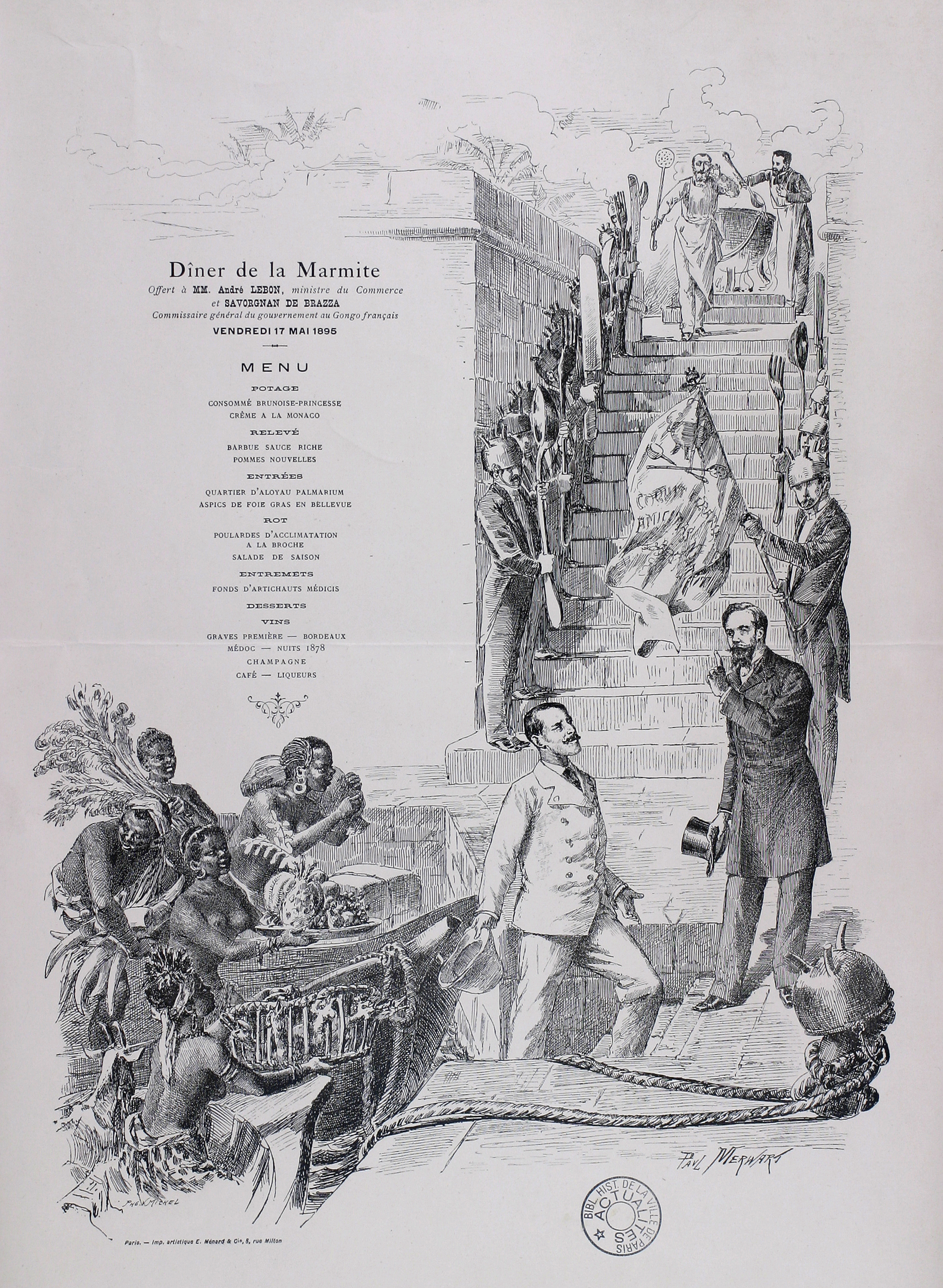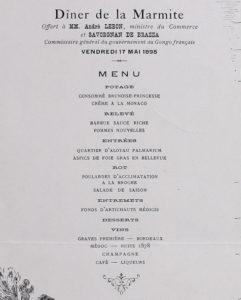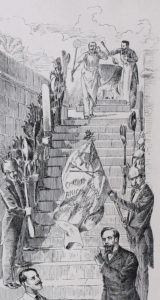By Michael Garval (Regular Contributor)
It’s said that beloved French Renaissance king Henri IV promised his subjects la poule au pot, a modest “chicken in every pot.” By the end of the nineteenth century, the expansion of the French colonial empire, with its self-appointed “civilizing mission,” and French gastronomy’s concurrent rise to international preeminence, urged on a more grandiose vision. France now promised the world civilization in every pot.

Paul Merwart, Banquet menu, May 17, 1895, Dîner de la Marmite, in honor of MM. André Lebon, Minister of Trade, and Savorgnan de Brazza, Governor General of the French Congo (Bibliothèque Historique de la Ville de Paris)
This 1895 banquet menu honors Pierre Savorgnan de Brazza, governor general of the French Congo, territory he explored and claimed for France (it was drawn by Paul Merwart, an artist fond of exotic subjects, who would later become the official painter of both the French colonies and the French navy). Brazza disembarks in France, as boats representing Africa – with native women and raw ingredients – moor at the quai. He is greeted by the other featured guest, trade minister André Lebon, who points Brazza, and our gaze, up a staircase, lined by a sort of honor guard in civilian evening dress.

Detail, Paul Merwart, Banquet menu, May 17, 1895, Dîner de la Marmite, in honor of MM. André Lebon, Minister of Trade, and Savorgnan de Brazza, Governor General of the French Congo (Bibliothèque Historique de la Ville de Paris)
Steep and massive, the stone staircase and embankments separate Africa below from France above. At top, at the pinnacle of frenchness, stands a giant pot, stirred by one chef as another summons guests. Brazza’s return is depicted as an ascent, from colonized lands to colonizer’s land, raw to cooked, ‘primitive’ to ‘civilized,’ with Africa as a foil for its presumed opposite. The viewer, like Brazza, is invited to step up for some French food. But what kind?
While La Marmite is the sponsoring organization’s name, the term, like its rough synonym le pot-au-feu, designates a French cooking vessel and its quasi-mythical contents – the primordial pot on the ancestral hearth, with boiled meats, vegetables, and stock, a simple, but emblematically French dish, like Henri IV’s poule au pot. Brazza, explorer of darkest Africa, had apparently come home to French comfort food. As in Roland Barthes’ example from his essay on “Steak and fries,” of General de Castries ordering french fries upon returning to France from Indochina, the pot-au-feu would function here as what Barthes calls “the alimentary sign of frenchness.”
Yet is this what Brazza would be served? The banquet menu, elevated literally and figuratively, like a commemorative, or sacred inscription, features such delicacies as Consommé Brunoise-Princesse, Barbue sauce Riche, Aspics de foie gras en Bellevue, not rustic fare from a steaming cauldron. And, despite African foodstuffs arriving, this is a thoroughly French dinner, from potage through café and liqueurs. Slippages occur, betwixt image and menu: home cooking yields to haute cuisine, exotic ingredients to classic French dishes.

Detail, Paul Merwart, Banquet menu, May 17, 1895, Dîner de la Marmite, in honor of MM. André Lebon, Minister of Trade, and Savorgnan de Brazza, Governor General of the French Congo (Bibliothèque Historique de la Ville de Paris)
The honor guard that stands at attention, to welcome Brazza, brandishes a flag emblazoned with the amiable motto of the literary-artistic association La Marmite (“Coquit cibaria nutrit amicitias”), as well as giant forks, spoons, and knives in place of arms. On their heads, instead of helmets, they wear small pots that echo the illustration’s central marmite theme. Silverware seems mightier than the sword, and helmets get beaten into cookware.
With its studiously mock-martial air, the menu proffers a characteristically French vision of colonialism, less as a military or even commercial enterprise than as a more expansively cultural one. The culinary refinement awaiting Brazza betokens broader French “civilization,” exported across the globe in the age of the great Auguste Escoffier, whose kitchens trained and then sent several thousand chefs out into the world, and whose 1903 Guide Culinaire served as the bible of classic French cuisine for generations. It was a time when ambitious kitchens everywhere emulated the French model, with fancy menus worldwide flogging pretensions in oft-approximate culinary French.
But what of the Africans Brazza has left behind? How might they have welcomed him to their land, and what might have been steaming in their pots? A series of popular articles about Brazza’s travels in West Africa, that he published in the magazine Le Tour du Monde in 1887-1888, provides some sort of answer. Here we encounter the tired old cliché about natives cooking and eating European explorers.
In one article Brazza’s fellow explorers question his zeal for forging ever deeper into unknown territory. They draw a two-fold caricature, envisioning divergent scenarios for his fate. In the first part, natives dance round a giant pot, une marmite gigantesque, presumed full with “white meat”; in the second, he has become so thin that the same natives thumb their noses at such an unappetizing morsel.
Brazza however held more enlightened views. A committed pacifist and humanitarian, he opposed slavery and championed better living conditions for the indigenous population. He quickly dismisses the first caricature, noting that the natives in question did not eat Europeans, while confirming the general scarcity of food that would make a European thin should he spend some time with them.
Still, one wonders if the 1895 menu for the banquet in Brazza’s honor might allude to this passage from just a few years earlier. The menu also features a giant marmite, yet in contrast to supposed native savagery, the pot offers a vision of french civilization.
 Michael Garval, Professor of French and Director of the interdisciplinary Master of Arts in Liberal Studies Program at North Carolina State University, also serves as Associate Editor of the journal Contemporary French Civilization. His research interests include celebrity, visual culture, and gastronomy. The author of ‘A Dream of Stone’: Fame, Vision, and Monumentality in Nineteenth-Century French Literary Culture, and of Cléo de Mérode and the Rise of Modern Celebrity Culture, he is currently working on a new book project, Imagining the Celebrity Chef in Post-Revolutionary France.
Michael Garval, Professor of French and Director of the interdisciplinary Master of Arts in Liberal Studies Program at North Carolina State University, also serves as Associate Editor of the journal Contemporary French Civilization. His research interests include celebrity, visual culture, and gastronomy. The author of ‘A Dream of Stone’: Fame, Vision, and Monumentality in Nineteenth-Century French Literary Culture, and of Cléo de Mérode and the Rise of Modern Celebrity Culture, he is currently working on a new book project, Imagining the Celebrity Chef in Post-Revolutionary France.
